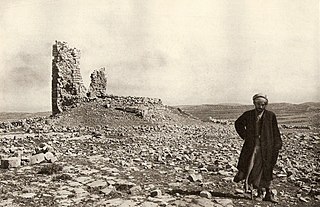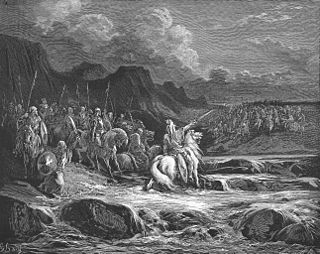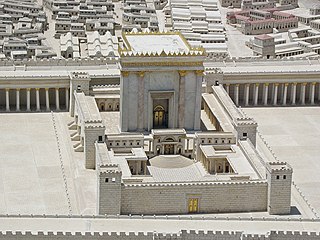Related Research Articles
This article concerns the period 169 BC – 160 BC.
Year 160 BC was a year of the pre-Julian Roman calendar. At the time it was known as the Year of the Consulship of Gallus and Cethegus and the Fourth Year of Houyuan. The denomination 160 BC for this year has been used since the early medieval period, when the Anno Domini calendar era became the prevalent method in Europe for naming years.
Year 164 BC was a year of the pre-Julian Roman calendar. At the time it was known as the Year of the Consulship of Torquatus and Longinus. The denomination 164 BC for this year has been used since the early medieval period, when the Anno Domini calendar era became the prevalent method in Europe for naming years.

Demetrius ISoter reigned as king of the Hellenistic Seleucid Empire from November 162 to June 150 BC. Demetrius grew up in Rome as a hostage, but returned to Greek Syria and overthrew his young cousin Antiochus V Eupator and regent Lysias. Demetrius took control during a turbulent time of the Empire, and spent much of his time fighting off revolts and challenges to his power from threats such as Timarchus and Alexander Balas.

Antiochus V Eupator, whose epithet means "of a good father" was a ruler of the Seleucid Empire who reigned from late 164 to 161 BC.

Judas Maccabaeus or Maccabeus, also known as Judah Maccabee, was a Jewish priest (kohen) and a son of the priest Mattathias. He led the Maccabean Revolt against the Seleucid Empire.

The Battle of Beth Zechariah took place around May 162 BC during the Maccabean revolt fought between Jewish rebels under the leadership of Judas Maccabeus against an army of the Seleucid Empire, the Greek successor state (diadochi) to the Macedonian conquests that controlled Syria and Babylonia. The battle was fought at Beth Zechariah and was a Seleucid victory, with the rebels driven from the field in retreat. Judas's brother Eleazar Avaran died in combat with a war elephant. The defeat allowed the Seleucids to continue their campaign and besiege the Jewish holy city of Jerusalem.

The Battle of Elasa was fought in April 160 BCE during the Maccabean Revolt between Judean rebels led by Judas Maccabeus and an army of the Seleucid Empire under the command of Bacchides. The battle resulted in the triumph of the Greek Syrian forces, the defeat of the Maccabees, and the death of Judas Maccabeus.

Jonathan Apphus was one of the sons of Mattathias and the leader of the Hasmonean dynasty of Judea from 161 to 143 BCE.
The Battle of Adasa was fought during the Maccabean revolt on the 13th of the month Adar, 161 BC at Adasa, near Beth-horon. It was a battle between the rebel Maccabees of Judas Maccabeus and the Seleucid Empire, whose army was led by Nicanor. The Maccabees won the battle after killing Nicanor early in the fighting. The battle came after a period of political maneuvering over several months where the peace deal established a year earlier by Lysias was tested by the new High Priest Alcimus, the new military governor Nicanor, and the Maccabee leader Judas Maccabeus.

The Battle of Beth Zur was fought between the Maccabees led by Judas Maccabeus and a Seleucid Greek army led by Regent Lysias in October 164 BC at Beth Zur. According to the books of Maccabees, the rebels won the battle, although how significant this victory really was is disputed; it is possible the battle's result was inconclusive. Through a stroke of good fortune for the rebels, the days after the battle likely coincided with news of Seleucid King Antiochus IV Epiphanes's death reaching Judea; rather than continue the campaign, the Seleucid army and Lysias returned to the capital to handle the leadership transition. The Maccabees were able to capture Jerusalem soon after.
Bacchides was a Syrian-Greek general and governor (strategos) and friend and advisor (philoi) of King Demetrius I Soter of the Seleucid Empire. The Seleucid Empire was one of the Greek successor states (diadochi) founded after the conquests of Alexander the Great, and was centered in Syria and Babylonia in the Hellenistic era.
Lysias was a 2nd-century BC general and governor of Syria under the Seleucid Empire.

The Acra, with the meaning of "stronghold", was a place in Jerusalem thought to have had a fortified compound built by Antiochus Epiphanes, ruler of the Seleucid Empire, following his sack of the city in 168 BCE. The name Acra was also used at a later time for a city quarter probably associated with the by-then destroyed fortress, known in his time to Josephus as both Acra and "the lower city". The fortress played a significant role in the events surrounding the Maccabean Revolt, which resulted in the formation of the Hasmonean Kingdom. The "upper city" was captured by Judas Maccabeus, with the Seleucid garrison taking refuge in the "Acra" below, and the task of destroying this last enemy stronghold inside Jerusalem fell to Simon Maccabeus surnamed Thassi. Knowledge about the Acra is based almost exclusively on the writings of Josephus, which are of a later date, and on the First and Second Books of Maccabees, which were written not long after the described events.

Eleazar Avaran, also known as Eleazar Maccabeus, Eleazar Hachorani/Chorani was the fourth son of Mattathias and the younger brother of Judas Maccabeus. He was killed at the Battle of Beth-zechariah during the Maccabean revolt.

The Maccabean Revolt was a Jewish rebellion led by the Maccabees against the Seleucid Empire and against Hellenistic influence on Jewish life. The main phase of the revolt lasted from 167 to 160 BCE and ended with the Seleucids in control of Judea, but conflict between the Maccabees, Hellenized Jews, and the Seleucids continued until 134 BCE, with the Maccabees eventually attaining independence.

During the Maccabean Revolt against the Seleucid Empire, there were a series of campaigns in 163 BC in regions outlying Judea - Ammon, Gilead, Galilee, Idumea, and Judea's coastal plain, a wider region usually referred to as either Palestine or Eretz Israel. The Maccabee rebels fought multiple enemies: Seleucid garrisons and hired mercenaries under a commander named Timothy of Ammon, non-Jewish inhabitants hostile to the Maccabees and their Jewish neighbors, and possibly the Tobiad Jews, a clan that generally favored the ruling Seleucid government. During 163 BC, the main Seleucid armies composed of Greeks were elsewhere, so the Maccabees were free to expand their influence against their neighbors.
The book 2 Maccabees contains 15 chapters. It is a deuterocanonical book originally written in Greek that is part of the Catholic, Eastern Orthodox, and Oriental Orthodox Christian biblical canons. It is still considered an important source on the Maccabean Revolt by Jews, Protestants, and secular historians of the period who do not necessarily hold the book as part of a scriptural canon. The chapters chronicle events in Judea from around 178–161 BCE during the Second Temple Period. Judea was at the time ruled by the Seleucid Empire, one of the Greek successor states that resulted from the conquests of Alexander the Great. 2 Maccabees was written by an unknown Egyptian Jew. The account is distinct from the book 1 Maccabees, which was written by someone in the Hasmonean kingdom that was formed after the success of the revolt. In general, 2 Maccabees has a more directly religious perspective than 1 Maccabees, frequently directly crediting prayers, miraculous interventions, and divine will for events.
Hellenistic Palestine is the term for historic Palestine during the Hellenistic period, when Achaemenid Syria was conquered by Alexander the Great in 333 BCE and subsumed into his growing Macedonian empire. After his death in 323 BCE, Alexander's empire was divided among his generals, the Diadochi, marking the beginning of Macedonian rule over various territories, including Coele-Syria. The region came under Ptolemaic rule beginning when Ptolemy I Soter took control of Egypt in 322 BCE and subsequently Yehud Medinata in 320 BCE due to its strategic significance. This period saw numerous conflicts as former generals vied for control, leading to ongoing power struggles and territorial exchanges.

The Second Temple period in Jewish history began with the end of the Babylonian captivity and the Persian conquest of the Babylonian Empire in 539 BCE. A new temple to replace the destroyed Solomon's Temple was built in Jerusalem by the returnees, and the Second Temple was finished around 516 BCE. Second Temple Judaism was centered around the religious leadership of the Second Temple, and lasted for six centuries. The Persians were largely tolerant of Judaism. Persian rule lasted for two centuries, but came to an end with the conquests of Macedonia under Alexander the Great in 332 BCE. Judea and the Eastern Mediterranean region came under Greek influence during the resulting Hellenistic period; Hellenistic Judaism blended both Greek and Jewish traditions. Judea was ruled in this period first by the Ptolemaic Kingdom and then by the Seleucid Empire, Greek states formed after the breakup of Alexander's Macedonian empire. The Maccabean Revolt of 167–142 BCE was initially a fight for Judean autonomy against a suppression of traditional Judaism by Seleucid King Antiochus IV, and later sought outright independence from Greek rule. The revolt's success brought about the formation of an independent Hasmonean kingdom of Judea, named for the family which had led the Jewish resistance.